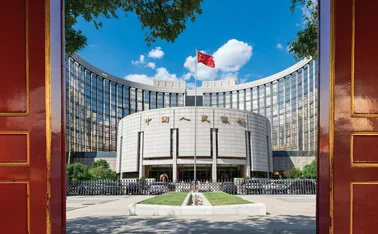
Banknote and currency services provider of the year: Innovia Security
Consistent collaboration key to success for polymer pioneer

Innovia Security, the manufacturer of polymer substrate Guardian, has remained at the vanguard of banknote service provision during the past year. The company was chosen by the Bank of England in March 2014 to provide material for its new £5 and £10 polymer banknotes in the UK. The deal with another G-7 national central bank represented an important milestone for Innovia, but it is the company’s consistent collaborative approach with a wide range of countries, ranging from Paraguay to Vanuatu, that makes it stand out.
A collaborative process
Innovia’s collaborative approach and commitment to service is highlighted by its work with the Bank of Canada, whose last two denominations of its Frontiers series (the C$5 and C$10 were introduced in November 2013), with the C$5 banknote unveiled on the International Space Station with much fanfare.
Ted Garanzotis, director of research in the currency department of the Bank of Canada, says the development of the Frontiers series required “a big investment and commitment from Innovia”, as well as other service providers and the Bank of Canada’s own staff. “We had strong collaboration, with weekly meetings with Innovia,” he says. “They invited us to their plants to get a first-hand account of how the material was doing in a large-scale ‘commercialisation’, which was important to us as a central bank.”
The demands imposed by the Canadians were challenging, with one aspect in particular nearly defeating Innovia. “We had to reinvent how to apply the foil on the substrate, says Paul Zientek, director of operations at the company. The Bank of Canada was the first central bank to stipulate it wanted foil on all its polymer banknotes, although the Reserve Bank of Australia had issued a commemorative A$10 dollar banknote in 1988 with a foil patch in a window.
“We had a number of difficulties in getting the foil on at speed, in terms of adhesion and getting the required quality of the foil application,” explains Zientek. The problem was so pronounced that Innovia “almost opted out” of the process, but then “made a breakthrough”. The solution was the “application of a large foil in a large, frameless window”, which has so far “proven to demonstrate durability and the mechanical strength required in the Canadian environment”, Zientek adds.
Reduced counterfeiting
Leading-edge security features stipulated by the Bank of Canada, including those provided by Innovia, have made the banknotes difficult to counterfeit but easy to verify. A large, transparent area extends from the top to the bottom of the note and contains complex holographic features that are viewable from both sides. These features plus active anti-fraud efforts by the Canadian authorities have translated into a much lower counterfeiting rate – in 2013 the Frontiers series amounted to much less than one part per million, according to data from the Bank of Canada.
Durability and savings
Increased durability was also important, with the new banknotes anticipated to have a lifetime of at least 2.5 times longer than ‘paper’ ones. “We have a circulation trial, where we have the ability to track a population of notes in circulation, so we can analyse how parameters evolve over time, and by that we can calculate the lifetime of the notes in circulation,” explains Garanzotis. “To date, we are meeting the target.”
Greater durability results in the need for much lower replacement volumes, which has cut costs for the Bank of Canada and also contributes to a reduced environmental impact, according to Yvonne de Lint, deputy chief of the currency department.
With a goal of having 100% polymer banknotes, the Bank of Canada is currently destroying all of the paper money being returned to it. “We implemented an accelerated replacement to increase the penetration of the new series,” says de Lint. In October 2014, more than 70% of all banknotes were polymer, in a total circulation of around 1.7 billion, she adds.
New notes in UK and New Zealand
The Bank of England will also rely on the Guardian substrate as the material for its new £5 and £10 notes, which will be released in 2016 and 2017, respectively.
The decision to choose the polymer, announced in March 2014, was the result of an “exhaustive three-year research process that carefully considered the substrate best suited to the future needs” of the new denominations, says Innovia.
Guardian will be manufactured at a new £20 million ($32 million) Innovia plant being built in Wigton, Cumbria, which will be up and running in 2016. The polymer is currently used for 78 denominations of banknotes in 24 countries.
The substrate manufacturer has also been working with the Reserve Bank of New Zealand (RBNZ) since 2013, on the development of its new Brighter Money series on polymer, with the first denominations due for release in 2015.
“During the process of designing and determining the specifications of the product, the Innovia team was very helpful technically and also allowed us to use external consultants,” explains Brian Hayr, head of currency at the RBNZ.
Another advantage of working with the company is that it takes “a realistic, longer-term view with its relationships and has taken customer feedback on board in a positive manner”, he adds.
Innovia’s track record is also praised by the Bank of Mexico, which has two denominations on polymer. “The customer service they provide has been always fast and good, and the technical support has a very high level,” says Alberto Mateos, director of the banknote factory of the central bank.
New technologies
Innovia is developing new banknote technologies. One of them is called Latitude, which is “a diffractive, optically variable effect that uses silver nanotechnology embedded in the substrate”, explains Zientek.
This new technology was used for the National Bank of Poland’s first polymer banknote, a 20 zloty note commemorating the centenary of the formation of the Polish Legions, which was launched in September 2014.
The biggest challenge in issuing this denomination was to switch from the initial paper base to polymer, and apply the substrate in “a way that the bill would not only serve the purpose of presenting new security elements, but would also have artistic value”, says Jerzy Dziemidowicz, senior product manager of currency at Polish Security Printing Works, the company commissioned to print the new banknote.
“Thanks to the co-operation with Innovia Security and the National Bank of Poland, as well as the designer, the emerging obstacles were overcome and thus a product has been created that will appeal to even the most demanding recipients,” Dziemidowicz says.
For its ongoing efforts in transforming the banknote landscape, counting its role in launching nine new denominations, – including the Paraguayan 5,000 guaranies; Mexican 50 peso; 200, 1,000 and 2,000 vatu; and the Mauritian 25 and 50 rupee – Innovia Securities has been the standout banknote and currency services provider of the year.
The Central Banking awards were written by Christopher Jeffery, Robert Pringle, Tristan Carlyle, Daniel Hinge, Arvid Ahlund and Maria Espadinha.
Only users who have a paid subscription or are part of a corporate subscription are able to print or copy content.
To access these options, along with all other subscription benefits, please contact info@centralbanking.com or view our subscription options here: http://subscriptions.centralbanking.com/subscribe
You are currently unable to print this content. Please contact info@centralbanking.com to find out more.
You are currently unable to copy this content. Please contact info@centralbanking.com to find out more.
Copyright Infopro Digital Limited. All rights reserved.
As outlined in our terms and conditions, https://www.infopro-digital.com/terms-and-conditions/subscriptions/ (point 2.4), printing is limited to a single copy.
If you would like to purchase additional rights please email info@centralbanking.com
Copyright Infopro Digital Limited. All rights reserved.
You may share this content using our article tools. As outlined in our terms and conditions, https://www.infopro-digital.com/terms-and-conditions/subscriptions/ (clause 2.4), an Authorised User may only make one copy of the materials for their own personal use. You must also comply with the restrictions in clause 2.5.
If you would like to purchase additional rights please email info@centralbanking.com








